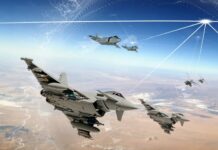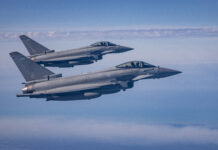![4000 hours and counting: Flying Tiger A-10 pilot hits notable milestone Pictured: Only once pre-flight checks have taken place to ensure protective gear, such as G-suits, harnesses, helmets, parachutes and more, is adjusted and is working properly, will Warthog pilots head out onto the tarmac for take-off. [USAF/2Lt Benjamin Williams]](https://euro-sd.com/wp-content/uploads/2025/06/1-In-the-cockpit-A-10C-taxis-for-take-off-Credit-USAF-2Lt-Benjamin-Williams-Kopie.jpg)
Improving the odds of survival
Tim Guest
Pilots and crew aboard fixed and rotary-wing military aircraft face numerous potential operational and peacetime-related emergency scenarios for which several items of personal protection and safety equipment will help improve their chances of survival.
This article looks at some of the and survival kit intended to keep military pilots and crew alive in the event of emergencies.
![Pictured: Only once pre-flight checks have taken place to ensure protective gear, such as G-suits, harnesses, helmets, parachutes and more, is adjusted and is working properly, will Warthog pilots head out onto the tarmac for take-off. [USAF/2Lt Benjamin Williams]](https://euro-sd.com/wp-content/uploads/2025/06/1-In-the-cockpit-A-10C-taxis-for-take-off-Credit-USAF-2Lt-Benjamin-Williams-Kopie-1024x682.jpg)
All these, and more, mean the potential for an emergency is ever present and must be prepared for through thorough training and the provision of effective personal protective and survival equipment. Flight suits, helmets, oxygen masks, safety vests, and survival packs — these are just some of the essential items that can significantly improve a crew member’s chances of survival, regardless of the aircraft. This applies whether it’s the pilot, co-pilot, and boom operator of a three-man KC-135 tanker; the four-person crew of a B-1B Lancer bomber; the individual pilot or two-person teams flying single- and two-seat variants of advanced jet fighters such as the Eurofighter Typhoon, Mirage 2000, and F-16; or the pilot of the slower yet formidable single-seat close air support workhorse — the A-10C Thunderbolt II.
Equipment potpourri
That said, different missions and different aircraft mean the particular type of protective and survival equipment on a flight will often vary, but in general terms will include: fire-retardant flight suits intended not only to keep the wearer warm and typically made of Nomex meta-aramid fibre, (developed by DuPont in the 1960s), but also to protect against heat and prevent burns – one suit of its kind is the one-piece CWU 27/P Nomex flight suit. G-suits/anti-gravity suits, worn on top of the flight suits of fighter crews, protect against the negative effects of extreme gravitational forces, including to eye-sight – grey-outs, tunnel vision, sight loss – or even complete loss of consciousness. Specialised flight helmets, typically custom-built for each individual wearer, which, while incorporating the likes of communications and noise-reduction technologies, helmet-mounted displays with advanced avionics functionality, and more, are crucial in protecting a pilot’s head from blunt-force trauma and windblast in an emergency, when ejection and a parachute landing might occur. They’re typically made of lightweight Kevlar, have visors to protect against sun glare and lasers, and are also designed to be used with oxygen masks, which are critical to ensure adequate oxygen levels at high altitudes and under extreme G-forces, particularly in an emergency.
![The MBU-20A/P oxygen mask varies the oxygen flow, automatically, depending on altitude and delivers supplemental oxygen to aircrew to prevent hypoxia at high altitudes, or in emergencies. [USAF/SSgt Sean Carnes]](https://euro-sd.com/wp-content/uploads/2025/06/2-KC-135-MBU-20A-P-oxygen-mask-Credit-USAF-Sean-Carnes-Kopie-1024x681.jpg)
Survival kit and toe-caps
Having mentioned ejection, it is also worth noting that pilots/two-man fighter crews wear steel-toed boots to protect their feet from injury during the ejection event. At the same time, seat safety vests and harnesses ensure individuals remain secure in their seats through such eventualities; protective breathing equipment, such as smoke hoods, are also part of a typical protective inventory, to prevent crew being overcome by toxic fumes and smoke. Then there’s equipment such as emergency locator transmitters to enable search and rescue (SAR) personnel to locate a downed aircraft, as well as portable halon fire extinguishers, fireproof gloves, and crash axes to help crew extinguish onboard fires and break through debris to escape a wrecked plane. For water landing scenarios, inflatable floatation collars automatically inflate to keep heads above water, life vests and single or multiple-person life rafts are also typical equipment for some aircraft. Additionally, all aircraft and crew will typically have some form of survival kit as part of their emergency egress gear, though not necessarily with the same contents, the latter depending on mission; items such as signal flares, folding knives, first-aid kits, flashlights, whistles, compasses, tactical radios, emergency rations and other items are regular contents.
Maker snapshot
Producing all that equipment, of course, are numerous companies across the defence industry. While there are too many to list here, some notable examples include the likes of Safran Aerosystems in France making anti-G suits, life jackets, and individual life rafts.
![Anti-G suit leakage testing in-house at Safran Aerosystems. Anti-G suits protect against the negative effects of extreme gravitational forces, such as grey-outs. [Safran]](https://euro-sd.com/wp-content/uploads/2025/06/3-Anti-G-trouser-leakage-testing-in-house-at-Safran-Credit-Safran-Kopie-1024x682.jpg)
Another company, Survitec, provides pilot and crew protection systems for non-fast jet and rotary-wing aircraft, and makes use of flame-retardant fabrics, such as Nomex and Kevlar, among its range of integrated kit ensembles, which include flight suits, water-escape garments, rafts and other equipment. Its modular Airpex Defender aircrew life preserver, for example, for front and rear aircrew, includes single and twin buoyancy options suited to different missions and while using flame-retardant textiles, also has a reduced heat burden to ensure comfort and wearer health/safety during extended missions. These are just a few of the many players in this field, a handful of equipment examples, and some of the considerations that go into ensuring pilot and crew protection and survival.
Ensuring Warthog pilots fly and survive
As an example, let’s take a closer look at one particular single-seat fighter jet workhorse – the A-10C Thunderbolt II, affectionately known as the ‘Warthog’. The A-10C has played an important CAS combat role in both US and allied operations globally, including deployments against ISIS in the Middle East. It takes round-the-clock, behind-the-scenes efforts to ensure the personal protection and survival equipment of each plane’s pilot is always fit and ready for every flight – and that’s where the 23rd Operation Support Squadron (OSS) and its AFE team comes in, no matter where the planes of the 23rd Wing/23rd Fighter Group are flying.
![A-10C Thunderbolt II pilot harnesses are inspected every 30 days by the AFE team. [USAF/A1C Deanna Muir]](https://euro-sd.com/wp-content/uploads/2025/06/4-A-10C-Thunderbolt-II-pilot-harness-is-inspected-every-30-days-by-AFE-team-Credit-USAF-Deanna-Muir-Kopie-1024x682.jpg)
The inspection shop, on the other hand, is where G-suits, harnesses, helmets and any other apparel worn by the pilot is inspected and maintained. Only once these activities are complete and pilots taken through pre-flight checks by the respective AFE teams to ensure everything is adjusted and working properly, will they head out onto the tarmac to fly. According to Air Combat Command, in the case of the Warthog, some 2,100 items of safety gear undergo these regular monthly, all-encompassing inspections. Beyond that, each AFE specialist airman undergoes extensive ongoing training in how to use all the equipment they work on, in order to stay up-to-date and, in turn, be able to train the pilots, effectively. Attending extreme arctic, land, and water survival courses, for example, provides experience of using survival kits in real situations, so AFE airmen can better impart first-hand and current knowledge to the pilots they train.
The last line of defence behind enemy lines
Other than a survival knife, one piece of kit not yet mentioned in the context of this article, is a personal weapon. Most pilots and crew in aircraft operationally deployed in a wartime theatre will typically have one, either a pistol or a light rifle, so it’s worth noting, in closing, that for the last five years the USAF has had 2,700 units of a new rifle it came up with in 2018, the Aircrew Self Defence Weapon (GAU-5A), deployed on many of its ejection-seat aircraft. Based on the M4 carbine and weighing just 3.3 kg, the 5.56 mm calibre rifle can hit a human-sized target at 200 m and is intended to provide a downed pilot with sufficient firepower to survive until rescue. The weapon breaks down into two main parts and, along with magazines, fits neatly into a standard ACES II ejector seat, and takes only 30 seconds to assemble. It is perhaps the last item of protection and survival kit a pilot wants to have to rely on, though nice to know it’s close at hand if needed.
![Aircrew Self Defence Weapon, GAU-5A, broken down with two magazines and tucked inside a standard ACES II ejector seat. It takes 30 seconds to assemble. [USAF]](https://euro-sd.com/wp-content/uploads/2025/06/5-GAU-5A-rifle-Credit-USAF-Kopie-1024x768.jpg)













